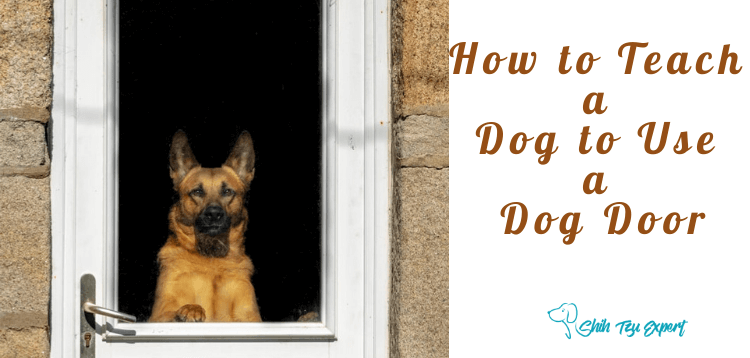
Training a dog to do anything takes patients and repetition. Training a dog to use a dog door is no different. With the right strategy and a good mindset, even the most fearful or stubborn dog can learn to use a doggie door. Training your dog to use a dog door is also relatively easy. Most dogs will pick it up after just one or two training sessions while more fearful dogs might take about a week to train.
Benefits of Having a Dog Door
There are quite a few benefits to having a doggie door for you and your pet. It can save you the trouble of having to get up every time your dog needs to go potty or every time they feel the need to double-check that the world outside hasn’t changed. For your dog, it means the luxury of freedom. The ability to come and go as they please.
A dog door can also provide some peace of mind that your dog isn’t being kept out in the elements for too long. If the dog gets too hot or cold or it starts to rain they can simply let themself inside. A doggie door will also make sure that even when your not home your dog can relieve themself and be free to get some fresh air.
How to know if a Dog Door is Best For You and Your Dog
Before you begin training your dog to use a dog door it’s important to consider some of the risks involved. If you have a small dog they may be susceptible to predatory attacks from animals such as hawks, foxes, or bobcats. This is especially true in rural areas. If this is the case it may not be advisable to allow the dog to be outside unattended.
If you have a larger dog you should consider whether the dog is likely to jump your fence or otherwise leave it’s designated yard. Finally, a doggie dog may allow unwanted critters like a raccoon to sneak into your house for a late-night snack.

Safety Measures to Consider Before You Begin Dog Door Training
Identify Reasons Your Dog Isn’t Using The Dog Door
The first step of training your dog to use a doggie door is to identify any challenges that might arise. This will allow for a smooth start to your training. For example, you should ensure that your doggie door is the right size for your dog. If the flaps are too large and heavy small dogs may have trouble pushing through them. If you have a small dog and a big dog in one household try taking the magnets out of the bottom of the dog door flaps until your smaller pet gets used to pushing through them.
Your dog may also have some underlying fears that you’ll need to address. It’s not uncommon for a dog to have anxiety about the door it’s self. They might not like how the flaps close around them or the way the door moves. It also possible that your dog doesn’t like being away from its people and doesn’t like the dog door because it causes separation. If your dog does have some separation anxiety it’s recommended that you condition the dog to be alone before you begin training them to use the doggie door.
Four Common Methods to Use When Dog Door Training
There are four simple methods to train your dog to use a dog door. One method is to play with your dog and trick them through the doggie door as part of the game. Another method is to have a partner gently nudge your pup out the doggie door as you call to them. If your dog responds best to food incentives use that to your advantage as the third method does. Coax your dog through the doggie door with a treat. If your dog has fears or anxiety about the dog door take it slow. Get your dog used to the door first before coaching them through it.
The success of each technique is often dependent on the dog and its personality. Don’t be afraid to try a different method if you don’t find success with the first method you try. It’s also important to remember the fundamentals of dog training; patience, repetition, and reward. If you start to get frustrated your dog will pick up on that and it will add to their stress level. A stressed dog will not be very receptive during training. Keep your training session short and fun. It should feel like playtime for you and your pup. Finally, make sure your dog knows when they’ve done something good by giving them a treat and showering them with pets and encouraging language.
Playtime Method
Step 1 – Get your dog moving
Before you begin interacting with your pet take the flaps off of the dog door. It will be much easier to get your pet to come through the dog door if they can see what’s on the other side. Next, begin playing with your dog. This could be some tug-of-war, a little fetch, or however you and your dog like to play.
Step 2 – Play through the dog door
Once the dog is engaged but not over-excited, position them on one side of the door. Then quickly move to the other side of the door with the toy. Now that you are opposite your pup begin playing with the toy. Hold the toy through the dog door and try to get the dog to grab on. Once the dog is engaged by the toy being gently pulling them through the door. Each time the dog successfully comes through the door be sure to let them know they have done something good. Use encouraging language and a little more playtime as a reward. Repeat this 5 to 10 times.
Step 3 – Increase the distance
When it is time to progress stop holding the toy through the door. Hold the toy just on the other side of the door and encourage your dog to come through the door in order to begin playing. Continue to increase your distance from the dog door as your pup grows in confidence. You can also try play bowing to your dog from the other side of the door and see if they will come through without the use of the toy. Be sure to reward your dog with playtime and praise each time they come through the door. Repeat 5 to 10 times.
Step 4 – Toss the toy
Next, you will want to get the dog to go through the door without anyone being on the other side. Both you and your dog will begin playing on the same side of the door. Then you will toss the toy through the door. Make sure to reward the dog each time he passes through the door. Once your dog has some confidence going through the door start tossing the toy further and future. Repeat 5 to 10 times.
Step 5 – Replace the flaps
Once the dog is comfortable using the dog door without the flaps it is time to replace them. Once they have been replaced repeat steps 2 through 4 again until your dog is comfortable using the dog door with the flaps. In the beginning, you may have to hold the flaps open for the dog to get them to understand how it works.
Step 6 – Dog door only
Now that your dog has the hang of using the doggie make that it’s their primary method of getting outside for a few weeks. Every time they need a potty break, use the dog door. It’s time to go outside from some playtime, use the dog door. You can even place the dog’s dinner on the other side of the doggie dog each night for a few weeks to ensure regular practice.
Things to remember about the playtime method
The playtime method should be lots of fun for your pet. Make sure you stop training before your pet losses interest or gets frustrated. For best results, your sessions should be short and frequent.
Dog Treat Method
Step 1 – Lure your dog
Initially, your dog may be reluctant to come all the way through the dog door so start small. Place your dog on one side of the door and yourself on the other with a treat in hand. Hold the treat just outside of the door so that your dog has to stick their head through the door to grab the treat. Give the dog the treat and praise each time their head pops through the door. Repeat 3 to 5 times.
Step 2 – Increase the difficulty
Once it’s time to progress only reward the pup if they fully come through the door. Use your hand to stick the treat just inside the door. Then slowly pull the treat back through the door with your dog in tow. Praise your dog and give them the treat as they come through the door. Remember to only help as much as you need to. The less luring you can do the better. Repeat 5 to 10 times or until your pet is confidently stepping through the door.
Step 3 – No treat
For the next progression, repeat step 2 but without a treat. Close your hand lightly as if you have a treat. Then use your hand to coax the dog through the door. Abbreviate your luring motions as you go until your dog will come through the door confidently. When your dog makes it through the door give them praise and a treat. Repeat 5 to 10 times.
Step 4 – Tossing the treat
By this point, some dogs will have figured out the doggie door and not need any more training but other dogs will still need some extra coaching. If this is the case for your dog try tossing a treat through the door for your dog to retrieve. Increase the distance of the toss as your dog gains confidence. Repeat 5 to 10 times.
Step 5 – Replace the flaps
If your dog is using the dog door confidently without the flaps it’s time to replace them. Repeat steps 1 through 4 until your sure the dog has figured out how to use their doggie dog. At first hold the flaps open for your pup, they might not realize they can push through the flaps.
Step 6 – Dog door only
Now that your dog has the hang of using the doggie make sure they only use that for a few weeks. Every time they need a potty break, coax them through the dog door. If it’s time to go outside from some exercise, encourage them to use the dog door. You can even place the dog’s dinner on the other side of the doggie dog each night for a few weeks to ensure regular practice.
Things to remember when using the entice/lure method
As mentioned with the playtime method your training sessions should not feel like work for you or your dog. They should be short fun interactions that end before frustration or boredom sets in.
Nudge Method
Step 1 – Removing the flaps
With this method, it’s especially important to remove the flaps before you begin training. Your pet may not release that the flaps move and nudging them toward the door may frighten them.
Step 2 – A gentle push
Have one person on the outside of the door with a treat in hand. A second person will gently nudge the dog through the doggie dog. Once the dog is through be sure to praise them and give them a treat. Repeat this 3 to 5 times.
Step 3 – Call the dog
For step 3 the person on the outside of the door will call the dog in an effort to coax them through the door. If the dog is still hesitant a gentle nudge can be used to assist the dog. To progress help the dog less and less on each attempt. Remember to give a treat and praise as the dog completes the task. Do this 5 to 10 times before taking a break or until the dog is confidently stepping through the door on their own.
Step 4 – Replacing the flaps
Once the dog is comfortable using the doggie dog without the flaps its time to replace them. This may confuse your dog but, don’t be discouraged. Holding the flaps open on the first few attempts will help with any confusion. Remember the idea is to only help as much as is needed. Be patient and let your puppy figure it out. Repeat 5 to 10 times or until the dog is confidently using the door.
Step 5 – Up the ante
To continue progressing add some more distance. If you’re calling to the dog from outside try taking a few steps back. You can also try starting your dog from further away from the door.
Step 6 – Dog door only
Finally, try not letting your dog use the regular door for a few weeks. When it’s time to go potty encourage them to use the dog door. When you want to take them outside for playtime coax them through the doggie door. It can also be a good idea to try putting dinner on the outside of the dog door for a few weeks so that your dog has regular practice.
Things to remember when employing the nudge method
The most important thing to remember about the nudge method is that it’s a nudge. You should not be forcefully pushing your pup through the dog door. This will only make training harder. Think about it like adding a small push when teaching a young child to ride a bike.
Dog Door Training For a Fearful Dog
Step 1 – Identifying the fear
Training will come easier if you can identify where your dog’s fear or anxiety is coming from. Your dog’s fear may come from a sound that your dog door makes or the way the door feels as they push through the door. Spend some time trying to identify your dog’s fear before you do anything else.
Your dog may also have some kind of separation anxiety. Separation anxiety can make dog door training difficult because using the door separates the dog from its people. It’s recommended that you accustomed your dog to being alone before you start dog door training.
Step 2 – Getting accustomed to the door
The first step in training a dog that is fearful of a doggie door is to get them comfortable being around the door. Take the flaps completely off and try holding the dog in your arms and sitting close to the door. Every time you get close to the door give your dog praise and a treat. Practice this on both sides of the door until your dog willing comes near the dog door for a treat.
Step 3 – Adding some distance
For step 3 start by standing on the opposite side of the door from your dog. Then call your dog so that they get close to the door. Once the dog gets close to the door give them praise and a treat. Do this 5 to 10 times or less if your dog is very uncomfortable. It’s important to watch for your dog’s needs and not push them too hard. This could cause the dog to become even more fearful of the door.
Step 4 – First steps through the door
Once your dog is comfortable getting near the door it’s time to move on. Sit on the opposite side of the door from your dog. Then hold a treat a few inches from the door and encourage your dog to stick their head through the door to get the treat. Gradually increase the distance of the treat from the door until your pup takes their first step through. Repeat this action 10 to 15 times
Step 5 – Set a new standard
Once your dog has taken their first steps through the door make that the standard. Use treats to coax your dog thought the door until they are confidently using the door to receive a treat. Do this 10 to 15 times or until your dog is confidently using the door.
Step 6 – Replace the flaps
Once the dog is confidently going through the door without the flaps it’s time to replace them. This may be a confusion transition for your pup so be patient, try holding the flap open at the beginning. If necessary start with step 2 and then work your way through the progression until your dog is confident using the door.
Step 7 – Increase the distance
Once it’s time to progress start increasing the distance. Sit farther back from the door and have your dog start farther back as well. Keep increasing the distance until you can stand a few feet from the door as your dog confidently steps through. To make it even more difficult hid this treat and try simple calling the dog through the door.
Step 8 – Dog door only
Once your dog is confident using the doggie dog make this their only way to get outside for a few weeks. When it’s time to go potty encourage them to use the dog door. When you want to take them outside for playtime coax them through the doggie door. It can also be a good idea to put dinner on the outside of the dog door so that your dog has regular practice using the doggie dog.

Things to remember when training a fearful dog
Besides being patient the most effective tool when training a fearful dog is positive reinforcement. Use lots of treats and even more encouraging words. If your pup does something good shower them with pets and love. Your dog is looking to you for cues about their surroundings if you indicate that it’s safe your dog will catch on.
Biggest Mistakes of Dog Door Training
Key Points to Remember When Dog Door Training
Dogs respond best to short frequent training sessions. Be sure to stop training before your dog losses interest and make sure that you remain consistent with daily training sessions. Another important thing to remember is patience. Training takes time. If you begin to feel frustrated with your pet take a break and try again later. Finally, don’t underestimate the power of positive reinforcement. Your dog is most happy when you are happy. If you communicate with your dog that a behavior is good it will stick much easier.
Eureka! Your Pet Loves The Dog Door Whats Next?
Once your dog learns how to use the dog door it’s not likely that you will have to train this skill again. Dogs don’t often forget behaviors that are of benefit to them. Once the dog has caught on, all you have to do is maintain the safety of the dog door and the area it leads to.
Dog doors can add some much-needed simplicity to your dog parenting life. A dog door could eliminate those endless trips to the backdoor and provide you peace of mind that you’re dog is never left outside in the elements. With the use of carefully applied training methods, your dog can be enjoying the luxury of a dog door in under a week.


![6 Best Dog Treadmills for 2023 [Buyer’s Guide] 6 Best Dog Treadmills for 2023 [Buyer’s Guide]](https://shihtzuexpert.com/wp-content/uploads/2019/04/Best-Dog-Treadmills-1.png)


